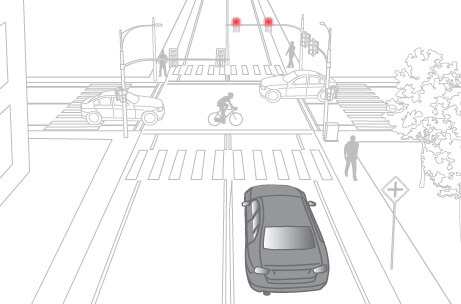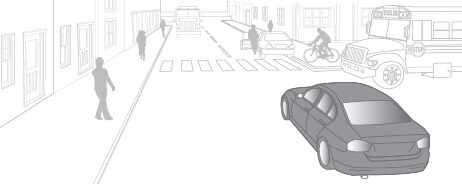10- City Driving
City driving – part one
Goal: Teach your teen to drive safely and confidently in the complex environment of city driving. Note: City driving takes hundreds of hours, if not several years, to master.
Location: Busy, urban streets. Start at times when traffic is light, moving on to heavier traffic times as your teen gains skill in this situation.
Skill review
Since the busy, crowded environment of city driving is challenging for new drivers, this is a good time to review key driving skills. One of the most important skill for drivers is the ability to make good decisions. City driving forces drivers to make lots of decisions quickly. The three things they need to drive safely in the city are:
- Visibility: To see potential problems in all directions
- Space: To maneuver around obstacles and avoid hazards
- Time: To anticipate risks and make adjustments to speed or position
Lesson one – maximizing visibility and space

Looking ahead to identify and anticipate potential problems is crucial for safe driving.
As you practice, have your teen focus on making decisions that will maximize visibility and space around the vehicle, increasing the available reaction time.
- Looking ahead (refer to Skill six): Congested city driving leaves very little room for error. Identifying and anticipating potential problems is crucial.
- Covering the brake: Coach your teen that when they spot a hazard, they should “cover” the brake by taking their foot off the accelerator and holding it over the brake. This will prepare them to slow down or stop suddenly. Make sure they don’t “ride” the brake. Riding the brake confuses other drivers and puts unnecessary wear on the brakes.
Lesson two – identifying hazards
As you begin city driving practice, have your teen drive through several blocks to identify and name common hazards on busy, congested streets. Ask them to describe how they will safely deal with each hazard they identify.
Such hazards may include:
- Parked cars, cars entering or exiting parking spaces, and car doors opening
- Delivery trucks stopping suddenly, with drivers racing to and from the trucks
- Buses making frequent stops, loading and unloading passengers
- Blind alleys, with cars or cyclists darting out
- Pedestrians and cyclists moving unpredictably, crossing streets outside of a crosswalk, etc.
- Limited visibility and intersections spaced at shorter intervals
- Aggressive drivers competing for lane space and parking spots
- Stop-and-go traffic flow
Scan first
Keep reminding your teen that constant awareness and looking ahead are key to driving safely on city streets. Emphasize the idea that a green light means, “Scan the intersection first, then go.”
City driving – part two
Goal: Teach your teen to drive safely and confidently in the complex environment of city driving. Note: This is not a goal that will be achieved in a single session. Spend as much time as possible with your teen practicing safe city driving skills.
Location: Busy urban streets. Start at times when traffic is light, moving on to heavier traffic times as your teen gains skill.
Lesson one – avoiding obstacles
Focus on lane position to avoid obstacles: City driving involves many circumstances in which travel lanes are shared, congested, and partially or fully blocked. During practice sessions on busy city roads, have your teen identify these steps to safely avoid obstacles:
- Identify right-lane obstacles, such as stopped buses, parked cars, delivery trucks, and cyclists.
- Identify left-lane obstacles, such as vehicles waiting to make a left turn, or cars traveling in the opposite direction drifting over the center line.
- Identify the least-congested travel lane. Hint: On a three-lane road, this is usually the center lane.
- Position the vehicle in the lane at the greatest distance possible from any obstacles.
It can be tempting to pass vehicles on congested streets, when obstacles or traffic volume slow traffic. However, this can be dangerous, due to closely spaced intersections, irregular traffic flow, cars entering and exiting parking spots, etc. Coach your teen to avoid passing on busy city streets.
Lesson two – deadly distractions

Remind your teen to stay alert, scan their surroundings, and not fixate on any one thing.
What happens inside the car can be just as dangerous as what happens outside. Engaging in distracting activities while driving can be deadly, especially for young drivers. Ask your teen to list dangerous driving distractions. Their answers should include:
- Talking or texting
- Changing radio stations, or shuffling/streaming music
- Dialing a phone
- Passengers, pets, or objects moving in the car
- Eating, drinking, or smoking
- Searching for an item
- Intense or emotional conversations, or cognitive distractions, such a trying to solve a problem
- Putting on makeup or looking in the mirror
Coach your teen to avoid distracting activities whenever possible, but especially in busy, congested environments. Remind them to focus on keeping as much space as possible around the vehicle at all times.
More is better
City driving skills take a long time to acquire. Spend as much time and drive in as many circumstances with your teen (night, inclement weather) as you are able. Plan trips to less-familiar places where you might not normally travel.